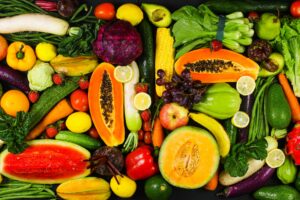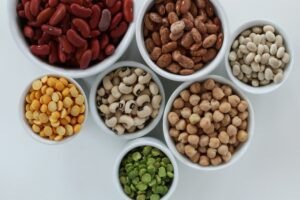The significance of packing nutritious and exciting lunch boxes cannot be overstated in today’s fast-paced world. Whether you’re a diligent professional seeking quick lunch ideas to sustain your energy through the workday or a caring parent dedicated to ensuring your child receives a balanced meal at school, selecting the healthy lunch boxes contents is crucial. This guide aims to provide you with a plethora of options that are not only delectable but also straightforward to prepare. From rainbow wrap sandwiches to edamame avocado dip, we’ve got everything to ensure your lunch boxes are brimming with flavor, nutrition, and a dash of creativity.
Crafting the Perfect Balanced Healthy Lunch Boxes
Creating a balanced lunch box is pivotal for fueling both the body and mind effectively throughout the day. A harmonious blend of food groups and macronutrients not only ensures sustained energy but also promotes overall well-being. To assemble healthy lunch boxes that is both fulfilling and nutritionally complete, consider incorporating the following essential components:
Proteins:
The building blocks of life, proteins are crucial for the repair and regeneration of tissues. Opt for:
- Lean meats such as chicken or turkey, offering high-quality protein without excess fat.
- Beans and legumes, excellent plant-based protein sources that also provide fiber.
- Tofu or tempeh, versatile soy products that can be easily flavored to suit any dish.
- Nuts and seeds, packed with protein and healthy fats, but use in moderation due to high calorie content.
Whole Grains:
Energize your day with whole grains that release energy gradually, keeping you full and focused. Include:
- Brown rice or quinoa, which are gluten-free options rich in fiber.
- Whole wheat bread or pasta, providing essential B vitamins and minerals.
- Consider oats as a base for homemade granola bars or as a cold oatmeal salad.
Fruits and Vegetables:
These colorful components are your main source of vitamins, minerals, and antioxidants. Aim to include:
- A variety of colors to ensure a wide range of nutrients.
- Both raw and cooked forms to maximize health benefits.
- Seasonal produce for the freshest taste and nutritional value.
Healthy Fats:
Essential for brain health and hormone production, healthy fats should not be overlooked. Sources include:
- Avocado, a versatile fruit that can be spread on sandwiches or diced into salads.
- Cheese, which adds flavor and calcium but should be used in moderation.
- Seeds, such as chia or flaxseed, which can be sprinkled over salads or integrated into smoothies.
Incorporating these elements into your lunch box not only ensures a delicious and varied meal but also supports your dietary needs, keeping you energized and healthy. Remember, a balanced lunch box is your secret weapon for a productive and vibrant day.
Easy and Nutritious Lunch Box Ideas
Crafting healthy lunch boxes both appealing and healthy doesn’t have to be a daunting task. Here are some easy and healthy lunch boxes ideas that cater to all tastes:
- Mac and Cheese with Peas: A comforting classic with a nutritious twist. Perfect for both kids and adults. For more delightful recipes, check out Yummy Toddler Food.
- Pesto Pasta Salad: Ideal for those who appreciate versatility in their meals. Add in some chicken or beans for extra protein.
- Pizza Muffins: These savory muffins are a hit for meal prep and can be enjoyed warm or cold.
- Turkey Wrap: A simple, yet satisfying option that pairs well with any side. Wrap it in a whole grain tortilla for an extra nutrient boost.
- Hummus and Pita: Quick to assemble and packed with flavor. A great vegetarian option that’s also filling.
- Snack Lunch: Think of a mini cheese board with fruits, veggies, cheese, and crackers. It’s fun and balanced.
- Chicken Meatballs: Serve them cold or warm with a side of sweet potato or mixed berries.
- Sandwich Roll-Ups: A creative take on the traditional sandwich that’s easy to eat and mess-free.
- Breakfast for Lunch: Who says pancakes and eggs are only for breakfast? They make a delightful lunch too.
- Grain Salad: Quinoa or farro salads are excellent make-ahead options that keep well.
Incorporating these ideas into your lunch planning ensures a balanced, delicious meal that you and your loved ones will look forward to. Each suggestion is designed to be nutritious, easy to prepare, and satisfying, making your lunch box a highlight of the day.
Tips for Packing a Lunch Box
Efficiently packing a lunch box is crucial for ensuring that meals remain fresh and enticing until it’s time to dive in. Here, we expand on essential strategies to elevate your lunch-packing game, ensuring every meal is a delight to uncover:
- Opt for Insulated Containers: The secret to keeping hot foods hot and cold foods cold lies in the use of insulated containers. These indispensable tools are key in preserving the freshness and safety of your meals, making them a non-negotiable in your lunch-packing arsenal.
- Evening Preparations: Acknowledge the chaos of mornings and shift your lunch prep to the evening before. This not only slashes morning stress but also gives you the leisure to pack thoughtfully and creatively.
- Embrace Variety: The magic ingredient to healthy lunch boxes is variety. Diversifying the contents not only banishes mealtime monotony but also ensures a comprehensive nutrient intake. Aim to include a spectrum of food groups, from proteins to whole grains, and a rainbow of fruits and vegetables.
- Creative Presentations: Never underestimate the power of a visually appealing meal. Employ cookie cutters for whimsical shapes or opt for compartmentalized boxes for a bento-inspired presentation. This not only captivates the eater’s interest but also makes the meal feel more personalized and special.
- Interactive Elements: Consider adding interactive elements to the lunch box, such as dips for veggies or a small DIY sandwich kit. This not only makes eating more fun but also encourages a hands-on approach to meals, particularly appealing to younger diners.
- Mindful of Allergies and Preferences: Tailor each lunch box to accommodate dietary restrictions and personal taste preferences. This thoughtful consideration ensures everyone can enjoy their meal worry-free.
By adhering to these enhanced tips, your lunch boxes will transcend mere nutrition to become a highlight of the day, eagerly anticipated and thoroughly enjoyed, regardless of where you or your loved ones are. Remember, the key to a successful lunch box lies not just in what you pack, but in how you pack it—with care, creativity, and a dash of fun.
Special Considerations
Crafting lunch boxes that cater to individual dietary requirements is essential in ensuring that everyone enjoys a safe, satisfying, and nutritious meal. Whether it’s navigating food allergies or adjusting portion sizes, here are comprehensive strategies to accommodate special dietary needs effectively:
Allergy-Friendly Alternatives
- Identify Safe Substitutes: For individuals with food allergies, identifying safe alternatives is paramount. Opt for gluten-free bread if dealing with wheat allergies, or choose sunflower butter as a nutritious alternative to peanut butter.
- Read Labels Carefully: Always check product labels for potential allergens. Many foods are processed in facilities that handle common allergens, so it’s crucial to select products certified as safe.
- Homemade Solutions: Whenever possible, prepare homemade versions of lunch box favorites. This allows full control over the ingredients, ensuring they meet dietary restrictions.
Portion Control for Varied Appetites
- Customize Portion Sizes: Tailoring portion sizes to the individual’s age and appetite ensures that they receive the right amount of nutrition without waste. Children typically require smaller portions compared to adults.
- Use Compartmentalized Containers: Bento boxes or compartmentalized containers are excellent for managing portion sizes. They also help in creating a balanced meal with a variety of food groups.
Additional Considerations
- Dairy and Gluten-Free Options: Incorporate dairy-free alternatives like almond milk yogurt or gluten-free grains such as quinoa to cater to lactose intolerance or celiac disease.
- Vegetarian and Vegan Choices: Include a range of plant-based proteins like lentils, chickpeas, or tofu to satisfy vegetarian and vegan dietary preferences.
- Mindful of Cross-Contamination: Be vigilant about cross-contamination, especially when preparing food for individuals with severe allergies. Using separate utensils and surfaces can prevent unintended exposure.
By implementing these strategies, you can ensure that your lunch boxes are not only inclusive but also diverse, nutritious, and enjoyable for all, regardless of dietary restrictions or preferences. Remember, the goal is to provide a meal that is both safe and delicious, catering to the unique needs of each individual.
Healthy Lunch Boxes Ideas for Various Diets
Embracing a variety of dietary preferences not only enriches our culinary repertoire but also ensures that everyone can enjoy delicious and nutritious lunches. Tailoring lunch boxes to fit vegetarian, vegan, gluten-free, and dairy-free diets is simpler than it appears. Here’s how to diversify your lunch box content to meet these needs effectively:
Vegetarian and Vegan Delights:
Plant-Based Proteins: Incorporate a variety of beans, lentils, chickpeas, and tofu to ensure a protein-rich meal. These ingredients are versatile and can be used in numerous dishes.
- Veggie Wraps: Utilize whole grain or gluten-free tortillas filled with a mix of grilled vegetables, hummus, or a bean spread.
- Salads with a Twist: Combine leafy greens with quinoa, nuts, seeds, and a hearty portion of fruits like apples or berries for a sweet crunch.
- Fruit Medleys: Don’t underestimate the power of a well-composed fruit salad, especially when paired with a sprinkle of chia seeds or a dollop of almond yogurt for extra nutrients.
Gluten-Free and Dairy-Free Innovations:
Grain Alternatives: Choose gluten-free grains such as rice, quinoa, or buckwheat to form the base of your meals. These grains offer flexibility and can be seasoned to match any flavor profile.
- Rice Bowls: Top with your choice of protein, such as grilled chicken or tofu, and an array of vegetables for a colorful and balanced meal.
- Quinoa Salads: Mix quinoa with black beans, corn, avocado, and a lime-cilantro dressing for a refreshing lunch option.
Dairy Substitutes: Almond milk, coconut yogurt, and cashew cheese are excellent dairy alternatives that can easily replace their traditional counterparts in any recipe.
- Smoothie Packs: Prepare ziplock bags with frozen fruits, spinach, and protein powder. Just add almond milk, blend, and enjoy a nutritious smoothie for lunch.
By thoughtfully selecting ingredients and recipes, you can assemble inclusive, delicious, and nutritious lunch boxes that cater to a broad spectrum of dietary preferences. This approach not only respects individual dietary needs but also introduces an exciting variety of flavors and nutrients into the daily diet, making every lunchtime a delightful experience.
FAQs
Q: What Are Some Quick and Healthy Lunch Box Ideas?
A: For those on the go, quick and healthy lunch box ideas are a must. Consider these options for a nutritious and satisfying midday meal:
- Whole Grain Wraps filled with lean protein (like turkey or tofu) and plenty of fresh veggies.
- Yogurt Parfaits with layers of Greek yogurt, fruit, and granola, offering a perfect blend of protein, fiber, and healthy fats.
- Rice Bowls with a base of brown rice, topped with colorful vegetables and a protein source like grilled chicken or beans.
Q: How Can I Make Lunch Boxes More Exciting for Kids?
A: Making lunch boxes exciting for kids is all about creativity and color. Try these tips to make lunchtime something they look forward to:
- Use Cookie Cutters to shape sandwiches and fruits into fun figures.
- Include a Small Treat or a note in the lunch box for a personal touch.
- Involve them in the Meal Planning Process, letting them pick some of the items that go into their lunch box.
These strategies can help make lunch boxes more appealing and enjoyable for kids, encouraging them to eat a balanced meal.
Q: What Are Some Allergy-Friendly Lunch Box Options?
A: For those with food allergies, finding safe lunch box options is crucial. Focus on whole foods and consider these allergy-friendly ideas:
- Fruits and Vegetables: Naturally free from most common allergens, they’re perfect for snacking or as side dishes.
- Gluten-Free Pasta Salad: Made with gluten-free pasta and a variety of veggies and protein sources.
- Allergy-Friendly Snack Bars: Many brands offer bars free from the top 8 allergens, perfect for a quick and safe snack.
Always check labels for potential cross-contamination if purchasing pre-packaged foods.
Conclusion
As we wrap up our guide on “What Food Should You Put in a Lunch Box?”, it’s clear that with a little planning and creativity, lunch boxes can be both nutritious and exciting. By incorporating a variety of food groups, catering to dietary needs, and keeping meals interesting, you can ensure that lunchtime is a highlight of the day. We encourage you to try out some of the ideas shared, experiment with your own creations, and most importantly, enjoy the process of preparing meals that are not only good for you but also delightful to eat.
Thank you for joining us on this culinary journey. Whether you’re packing a lunch for yourself or for your loved ones, remember that every meal is an opportunity to nourish the body and soul. Here’s to lunch boxes filled with joy, color, and health!
We hope this guide has inspired you to elevate your lunch box game. For more tips, recipes, and ideas, be sure to check out our resources at Yummy Toddler Food, The Nutrition Source, and McCormick. Happy lunch packing!



